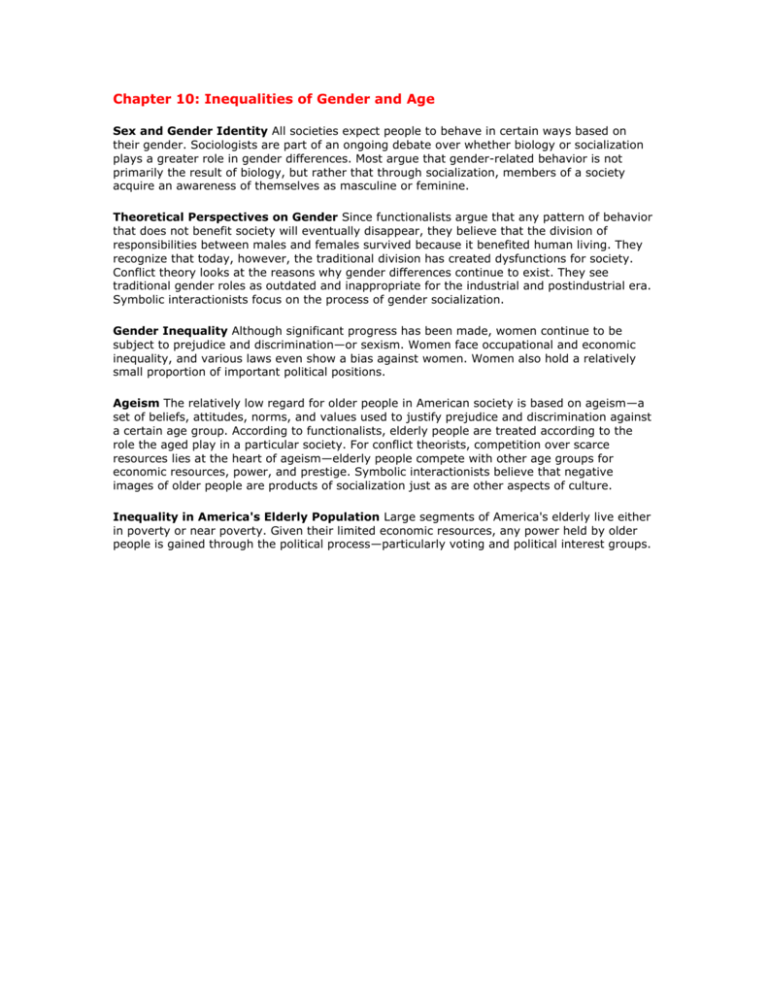Chapter 10: Inequalities of Gender and Age
advertisement

Chapter 10: Inequalities of Gender and Age Sex and Gender Identity All societies expect people to behave in certain ways based on their gender. Sociologists are part of an ongoing debate over whether biology or socialization plays a greater role in gender differences. Most argue that gender-related behavior is not primarily the result of biology, but rather that through socialization, members of a society acquire an awareness of themselves as masculine or feminine. Theoretical Perspectives on Gender Since functionalists argue that any pattern of behavior that does not benefit society will eventually disappear, they believe that the division of responsibilities between males and females survived because it benefited human living. They recognize that today, however, the traditional division has created dysfunctions for society. Conflict theory looks at the reasons why gender differences continue to exist. They see traditional gender roles as outdated and inappropriate for the industrial and postindustrial era. Symbolic interactionists focus on the process of gender socialization. Gender Inequality Although significant progress has been made, women continue to be subject to prejudice and discrimination—or sexism. Women face occupational and economic inequality, and various laws even show a bias against women. Women also hold a relatively small proportion of important political positions. Ageism The relatively low regard for older people in American society is based on ageism—a set of beliefs, attitudes, norms, and values used to justify prejudice and discrimination against a certain age group. According to functionalists, elderly people are treated according to the role the aged play in a particular society. For conflict theorists, competition over scarce resources lies at the heart of ageism—elderly people compete with other age groups for economic resources, power, and prestige. Symbolic interactionists believe that negative images of older people are products of socialization just as are other aspects of culture. Inequality in America's Elderly Population Large segments of America's elderly live either in poverty or near poverty. Given their limited economic resources, any power held by older people is gained through the political process—particularly voting and political interest groups. Chapter 10: Inequalities of Gender and Age "Gender Socialization in Schools" Introduction In this chapter, students learned about the concepts of sex, gender, and gender identity, as well as the inequalities people sometimes experience based on their gender. The gender socialization of children begins immediately, from the time they are born, and the consequences of this early socialization can be lifelong. The differences in the gender socialization of boys and girls in school significantly impacts their academic success in certain subjects and affects which subjects they choose to pursue as their future careers. In this activity students will take a closer look at the causes and consequences of gender socialization in schools. Lesson Description Students will visit a Web site that discusses the effects of gender socialization on the achievements of boys and girls in mathematics, science, and computers. The article examines the many different ways in which girls and boys are socialized from a very young age toward society's pre-established sex roles. After answering several questions about the article, students will write action plans for teachers and administrators of primary schools on gender socialization. Instructional Objectives 1. Students will be able to describe how gender socialization influences the educational experience of males and females. 2. Students will be able to explain why male socialization favors them in future math and science undertakings. 3. Students will be able to postulate solutions for more equitable gender socialization. Student Web Activity Answers 1. By playing with action toys, boys learn mathematical concepts—velocity, angles, three-dimensional configuration—and to be comfortable in a physical world. Later, they can transfer these skills to math concepts and can visualize math processes. Girls lose out on some of this experiential base when they are not encouraged in the active, physical world. 2. Females place most emphasis on mutual support and the building of collaborative knowledge, while male priority is on individual expertise and the presentation and debate around abstract concepts. 3. Whether or not a student likes a class is based in part on the student's feelings of success in the class—both academic achievements and felt experiences. The belief that a subject has utility for a student's life is another factor that influences the like or dislike of a subject. 4. From birth females are socialized against risk-taking and exploring the world around them and are given toys that encourage relational or nurturing activities, while boys are given toys that encourage motor skills and spatial visualization. Child care providers responded to children's attempts to communicate differently based on their own sex role beliefs. A study found that in preschool girls were socialized to assume a less aggressive role in conversation. 5. Students' action plans will vary. Go To Student Web Activity Student Web Activity- Chapter 10 NAME________________________ YOUR THOUGHTS: Answer these four questions using your own thoughts and experiences. 1. How does the fact that boys are encouraged to play with action toys while girls are encouraged to express themselves verbally impact their future mathematical skills? 2. Describe the difference between male and female communication. 3. Name two or more factors that help to determine whether or not a student will like a particular subject? 4. What are some examples cited by the researchers of ways that parents, child care providers, and preschool teachers perpetuate gender stereotypes? Here are the answers. Read the answers and then discuss if you shared the same thought or experiences as the researcher for each question. 1. How does the fact that boys are encouraged to play with action toys while girls are encouraged to express themselves verbally impact their future mathematical skills? By playing with action toys, boys learn mathematical concepts—velocity, angles, threedimensional configuration—and to be comfortable in a physical world. Later, they can transfer these skills to math concepts and can visualize math processes. Girls lose out on some of this experiential base when they are not encouraged in the active, physical world. 2. Describe the difference between male and female communication. Females place most emphasis on mutual support and the building of collaborative knowledge, while male priority is on individual expertise and the presentation and debate around abstract concepts. 3. Name two or more factors that help to determine whether or not a student will like a particular subject? Whether or not a student likes a class is based in part on the student's feelings of success in the class—both academic achievements and felt experiences. The belief that a subject has utility for a student's life is another factor that influences the like or dislike of a subject. 4. What are some examples cited by the researchers of ways that parents, child care providers, and preschool teachers perpetuate gender stereotypes? From birth females are socialized against risk-taking and exploring the world around them and are given toys that encourage relational or nurturing activities, while boys are given toys that encourage motor skills and spatial visualization. Child care providers responded to children's attempts to communicate differently based on their own sex role beliefs. A study found that in preschool girls were socialized to assume a less aggressive role in conversation. Were most of your answers similar to the research? If yes, explain why they were similar. If no, explain why you think they were different. Imagine that you have been hired to devise an action plan for more equitable socialization of preschool and elementary school children. Prepare a handout that you would distribute to teachers and administrators at a meeting about this topic. What advice would you give them? What sorts of activities should they encourage? What should they try to avoid doing? Give them as many concrete examples and ideas for activities as you can. Conduct additional research if necessary. 1. List three things teachers should do to treat girls and boys the same in class. 1. 2. 3. 2. List three activities that boys and girls could do and be treated equally while they are completed. 1. 2. 3. 3. List three things that teachers should NOT do when working with students. (How do teachers treat boys and girls differently?) 1. 2. 3.








